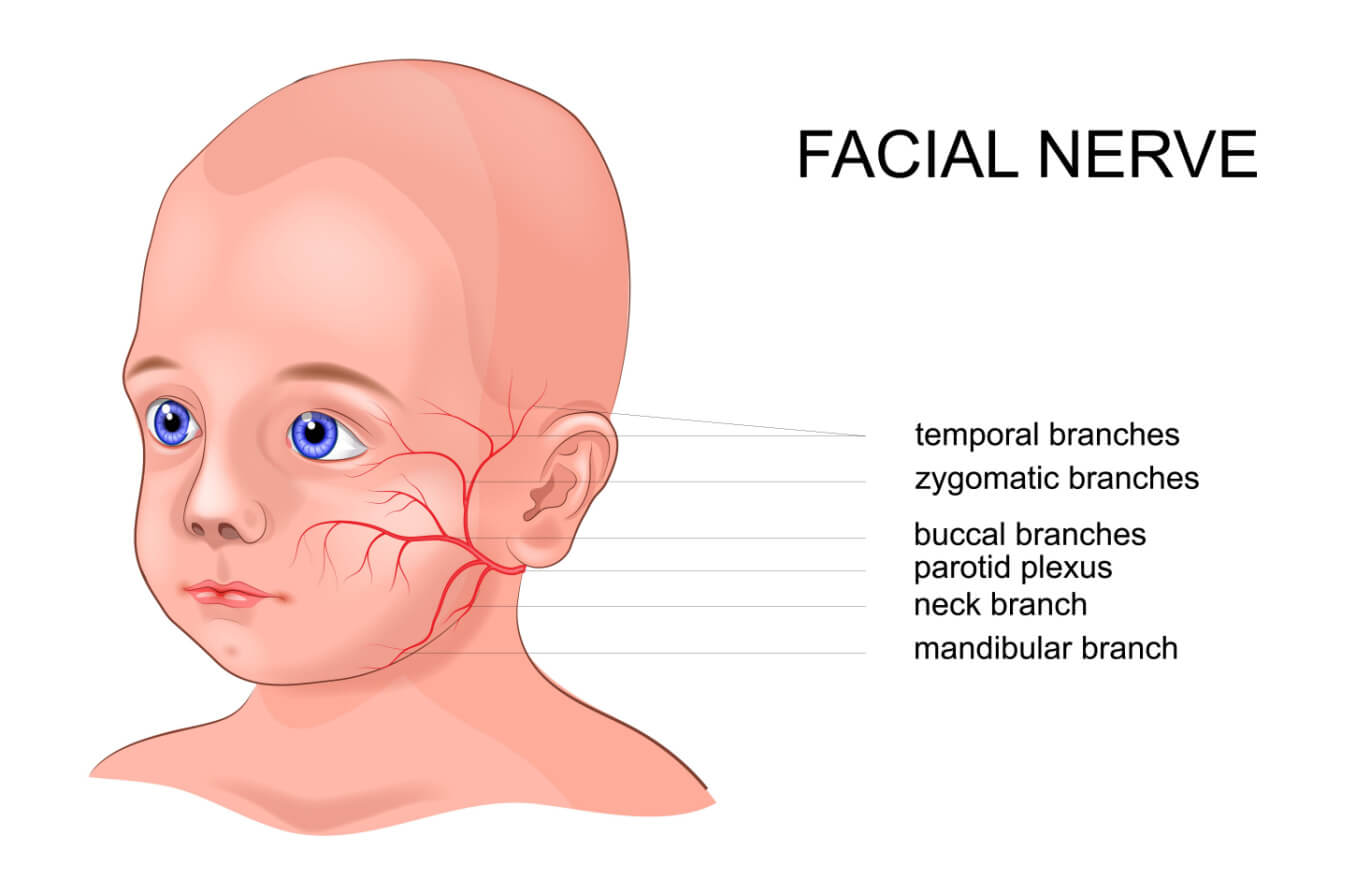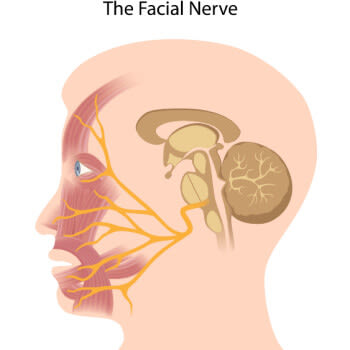Synkinesis

What is synkinesis?
Synkinesis is a condition that arises during nerve recovery. When a nerve is damaged, the body attempts to regrow and repair it. In some instances, the nerve does not regenerate along the same pathway. In such cases, it may end up innervating (supplying) a different muscle entirely.
Improper nerve recovery can cause the involuntary movement of muscles when attempting to move other parts of the face or body. For instance, smiling might cause one of the eyes to close or blinking causes the cheek or lip to move. Synkinesis may not only cause aesthetic concerns for an individual. It might also impair the normal function of the eyes or facial muscles.
Facial synkinesis
Synkinesis commonly affects the seventh cranial nerve known as the facial nerve. When this occurs, the condition is called facial synkinesis.

Facial nerve locations
The facial nerve helps the facial muscles function correctly. It enables movements like smiling and other expressions. This nerve also innervates the lacrimal gland of the eye. The lacrimal gland helps control tear production.
Damage to this nerve can lead to facial palsy (paralysis). Synkinesis following facial paralysis can affect any area of the face.
An estimated 9% to 55% of people with facial paralysis develop synkinesis.
Oculomotor synkinesis
Synkinesis may also impact the third cranial nerve (oculomotor nerve). In these instances, the condition is called oculomotor synkinesis.

Location of the oculomotor nerve (III)
The oculomotor nerve assists with eye movement. It allows the eye to look up, down and side to side. The nerve also enables the lifting of the upper eyelid. Damage to this nerve can lead to nerve dysfunction, which may result in synkinesis.
Oculomotor synkinesis affects the movement of the eyes, eyelids, or muscles around the eye when moving a different part of the face. It can arise following any disruption of normal nerve activity.
Causes of synkinesis
Synkinesis commonly develops weeks to months after nerve paralysis or damage has occurred. In some instances, synkinesis may arise from other factors. The causes of synkinesis can vary based on the reason behind the nerve condition.
Facial synkinesis
Various forms of facial palsy from damage to the facial nerve may lead to the development of synkinesis. These include Bell’s palsy and Ramsay Hunt syndrome.
Bell’s palsy is the sudden paralysis or weakening of the muscles in one half of the face. It is often caused by viral infections. Such infections may lead to swelling or inflammation that damages the facial nerve. The condition is usually temporary. Up to 30% of patients with Bell’s palsy develop synkinesis.
Ramsay Hunt syndrome causes inflammation of the facial nerve. The condition results from the varicella-zoster virus. (Varicella zoster is the virus that causes chickenpox and shingles.) Approximately 40% of people with Ramsay Hunt syndrome experience synkinesis.
Oculomotor synkinesis
Congenital cranial dysinnervation disorders (CCDD) may cause oculomotor synkinesis. (Congenital conditions are those present from birth.) The most common CCDD disorders are Marcus Gunn jaw winking ptosis and Duane retraction syndrome.
Oculomotor synkinesis may arise on its own or following nerve oculomotor nerve paralysis. It may also occur alongside other eye movement disorders.
Signs and symptoms of synkinesis
The effects of synkinesis may vary in severity. Some patients experience subtle abnormal movement of the facial muscles. Others have effects that are more noticeable or even disfiguring.
Signs and symptoms of facial synkinesis may include:
Involuntary facial movements
Cheek lifting when raising the eyebrows
Cheek lifting when closing the eyes
Brow lifting when smiling
Squinting when smiling
Tightness or stiffness of the cheek
Narrowing of the eyes
Neck pain
Headaches
Signs and symptoms of oculomotor synkinesis may include:
Movement of the eyes or eyelids when eating
Inward movement of the eyes when looking up or down
Pseudo von Graefe’s sign (lifting of the eyelid when looking downward or inward)
Pseudo-Argyll Robertson pupil (pupils do not constrict appropriately in bright light)
Binocular diplopia (double vision due to eye misalignment)
Ptosis (drooping of the eyelid)
Anisocoria (unequal pupil sizing)
Some cases of synkinesis involve excessive tearing. In these instances, the eye may produce tears when a person chews or uses the muscles around the mouth.
Treatment options
The management of synkinesis often requires a multidisciplinary approach. It also depends on the type of synkinesis present. Treatment varies according to severity and the patient’s individual needs.
Facial synkinesis
Facial synkinesis treatment focuses on restoring normal muscle movement. It may include one or more of the following options.
Physical therapy
Facial exercises can help retrain the muscles and prevent muscle atrophy. Repeating specific exercises can encourage voluntary control over facial movements. Massaging the area where involuntary contraction occurs can also be effective.
Biofeedback can make patients more aware of their facial expressions and movement. These techniques can include mirror feedback and tape feedback therapy. Tape feedback involves placing tape around the patient’s mouth. This can help enhance the sensation of involuntary muscle movement.
Other options involve mime therapy and electrical stimulation of the facial muscles.
Botulinum toxin A injections (BOTOX)
BOTOX can reduce the movement of muscles that are contracting involuntarily. The effects of this treatment last around three months.
Surgery
Severe cases of facial synkinesis can require surgery. This may involve the full or partial removal of the affected nerve or muscle(s). Muscle tissue transfer or nerve transfer procedures may also be performed.
Treatment can improve the effects of synkinesis. It may not restore facial function to its original state, however.
Oculomotor synkinesis
Treatment of oculomotor synkinesis is based on the individual needs of each patient. These could include:
Patching
Patching therapy involves covering the eye unaffected by involuntary movement. It can help strengthen muscle control over the affected eye.
Prism therapy
Prism therapy can improve double vision caused by oculomotor synkinesis. With this approach, the patient wears eyeglasses that contain a prism. The prism bends the light as it enters the eye, directing it to the correct area of the retina. This allows the brain to merge dual images into a single image.
Surgery
Surgery may help establish proper alignment of the eyes.
READ NEXT: What is a neuro-ophthalmologist?
Prognosis and living with synkinesis
Synkinesis can have a mild or significant impact on quality of life. Activities like eating and drinking may be challenging. Talking, speaking, smiling and expressing emotion may also be impaired. These factors can cause emotional or psychological distress. Such effects may lead some individuals to avoid social situations.
Facial synkinesis can improve with treatment and ongoing therapy. Some cases may be completely reversed with care. Identifying and treating the condition early on is important for minimizing its effects.
The prognosis for oculomotor synkinesis is dependent upon the underlying cause.
Too much or too little? A systematic review of postparetic synkinesis treatment. Journal of Plastic, Reconstructive, & Aesthetic Surgery. March 2020.
Bell’s palsy complications. News Medical Life Sciences. February 2019.
Neuroanatomy, cranial nerve 7 (facial). StatPearls. July 2022.
Facial paralysis. Cleveland Clinic. December 2022.
Botulinum toxin type A to improve facial symmetry in facial palsy: A practical guideline and clinical experience. Toxins. February 2021.
Oculomotor synkinesis. EyeWiki. American Academy of Ophthalmology. April 2023.
Oculomotor nerve. Cleveland Clinic. August 2021.
Decreased ACKR3 (CXCR7) function causes oculomotor synkinesis in mice and humans. Human Molecular Genetics. September 2019.
Facial synkinesis: A distressing sequela of facial palsy. Ear, Nose & Throat Journal. November 2021.
Ramsay Hunt syndrome. StatPearls. March 2023.
Bell’s palsy. Cleveland Clinic. May 2020.
Facial-stapedial synkinesis following acute idiopathic facial palsy. Wisconsin Medical Journal. July 2020.
Loss of CXCR4/CXCL12 signaling causes oculomotor nerve misrouting and development of motor trigeminal to oculomotor synkinesis. Investigative Ophthalmology & Visual Science. October 2018.
Congenital cranial dysinnervation disorders. EyeWiki. American Academy of Ophthalmology. August 2022.
Congenital third nerve palsy. EyeWiki. American Academy of Ophthalmology. February 2023.
What are the signs of Bell’s palsy recovery? Medical News Today. February 2023.
Understanding oral motor disorders: Synkinesis. Herman Ostrow School of Dentistry of USC. March 2020.
What is prism correction in eyeglasses? American Academy of Ophthalmology. April 2023.
Facial synkinesis in patients with long-standing Bell’s palsy is a reversible consequence of disruption of reciprocal inhibition caused by prolonged absence of proprioceptive feedback. Journal of the Neurological Sciences. October 2019.
Page published on Wednesday, June 28, 2023
Page updated on Wednesday, July 5, 2023
Medically reviewed on Friday, May 19, 2023






